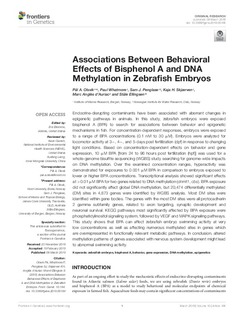| dc.contributor.author | Olsvik, Pål Asgeir | |
| dc.contributor.author | Whatmore, Paul | |
| dc.contributor.author | Penglase, Sam J. | |
| dc.contributor.author | Skjærven, Kaja Helvik | |
| dc.contributor.author | d'Auriac, Marc Anglès | |
| dc.contributor.author | Ellingsen, Ståle | |
| dc.date.accessioned | 2019-06-24T07:57:04Z | |
| dc.date.available | 2019-06-24T07:57:04Z | |
| dc.date.created | 2019-03-08T12:09:55Z | |
| dc.date.issued | 2019 | |
| dc.identifier.citation | Olsvik, P. A., Whatmore, P., Penglase, S. J., Skjærven, K. H., d'Auriac, M. A. & Ellingsen, S. (2019). Associations Between Behavioral Effects of Bisphenol A and DNA Methylation in Zebrafish Embryos. Frontiers in Genetics. 10: 184. doi: | nb_NO |
| dc.identifier.issn | 1664-8021 | |
| dc.identifier.uri | http://hdl.handle.net/11250/2601778 | |
| dc.description.abstract | Endocrine-disrupting contaminants have been associated with aberrant changes in epigenetic pathways in animals. In this study, zebrafish embryos were exposed bisphenol A (BPA) to search for associations between behavior and epigenetic mechanisms in fish. For concentration-dependent responses, embryos were exposed to a range of BPA concentrations (0.1 nM to 30 μM). Embryos were analyzed for locomotor activity at 3-, 4-, and 5-days post fertilization (dpf) in response to changing light conditions. Based on concentration-dependent effects on behavior and gene expression, 10 μM BPA [from 24 to 96 hours post fertilization (hpf)] was used for a whole-genome bisulfite sequencing (WGBS) study searching for genome-wide impacts on DNA methylation. Over the examined concentration ranges, hyperactivity was demonstrated for exposures to 0.001 μM BPA in comparison to embryos exposed to lower or higher BPA concentrations. Transcriptional analysis showed significant effects at >0.01 μM BPA for two genes related to DNA methylation (dnmt1, cbs). BPA exposure did not significantly affect global DNA methylation, but 20,474 differentially methylated (DM) sites in 4,873 genes were identified by WGBS analysis. Most DM sites were identified within gene bodies. The genes with the most DM sites were all protocadherin 2 gamma subfamily genes, related to axon targeting, synaptic development and neuronal survival. KEGG pathways most significantly affected by BPA exposure were phosphatidylinositol signaling system, followed by VEGF and MAPK signaling pathways. This study shows that BPA can affect zebrafish embryo swimming activity at very low concentrations as well as affecting numerous methylated sites in genes which are overrepresented in functionally relevant metabolic pathways. In conclusion, altered methylation patterns of genes associated with nervous system development might lead to abnormal swimming activity. | nb_NO |
| dc.language.iso | eng | nb_NO |
| dc.publisher | Frontiers Media | nb_NO |
| dc.rights | Navngivelse 4.0 Internasjonal | * |
| dc.rights.uri | http://creativecommons.org/licenses/by/4.0/deed.no | * |
| dc.subject | Epigenetikk | nb_NO |
| dc.subject | Epigenetics | nb_NO |
| dc.title | Associations Between Behavioral Effects of Bisphenol A and DNA Methylation in Zebrafish Embryos | nb_NO |
| dc.type | Journal article | nb_NO |
| dc.type | Peer reviewed | nb_NO |
| dc.description.version | publishedVersion | nb_NO |
| dc.rights.holder | © The Author(s) | |
| dc.subject.nsi | VDP::Genetikk og genomikk: 474 | nb_NO |
| dc.source.pagenumber | 18 | nb_NO |
| dc.source.volume | 10 | nb_NO |
| dc.source.journal | Frontiers in Genetics | nb_NO |
| dc.identifier.doi | 10.3389/fgene.2019.00184 | |
| dc.identifier.cristin | 1683253 | |
| dc.relation.project | Norges forskningsråd: 228877 | nb_NO |

